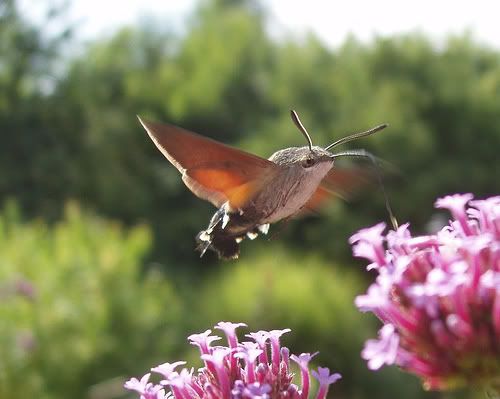My interest has now broadened to include pollinators in general. A couple of summers ago, I found this book in the gift shop at Fort Ross State Historic Park in Jenner, California:
The authors, Stephen L. Buchman and Gary Paul Nabhan, discuss the world's ecological crisis from the angle of declining pollinator populations. I've been reading this book a little at a time for quite awhile now. Alas, I was saddened to read that honeybees introduced into a region by beekeepers often contribute to the decline of native pollinators. But it's been stimulating to learn about other kinds of pollinators and how they operate.
I've recently come into a relationship with hummingbirds. An old Native man that I met one day at Wal Mart, of all places, asked me to give him my open palm, and he held his hand over mine and told me he was giving me hummingbird energy. I didn't think much of it at the time, except that an immediate feeling of peace and joy came over me. A couple of weeks later, though, I went on a private camping retreat at Sipapu Ski and Summer Resort in the Carson Forest. There were more hummingbirds there than I have ever seen in my life. I was sitting on the second floor of the lodge having lunch in the snack bar, and I looked out the window at the tall pines. There were many tiny birds in the branches, which I didn't immediately recognize as hummingbirds because they were sitting still. When I walked out onto the balcony, one flew right up to me at eye level and hovered there for a few moments, long enough for me to say Hi. Thanks for coming.
That same week, there was a bat nestled above my front door for a couple of days. (I didn't even know bats were pollinators until I started reading that book.) And that was also the week I started walking to San Francisco de Asis (see previous post). There are beds of fragrant purple flowers lining the walkway of the church, and this is where I like to sit when I'm there, in front of the statue of St. Clare. While I was there that first evening, an abundance of tiny winged creatures started flitting through the flowers. At first I thought they were hummingbirds, but they were smaller and more insect-like. They were also less concerned about my presence than hummingbirds would have been. Several flew around me and sucked nectar from flowers right next to me. Sometimes one would be so close I could watch the long proboscis straighten out into a blossom like a fishing line into a river, then quickly curl up into the creature's mouth. I can only describe the feeling they evoked in me as goofy euphoria. When I went home I looked them up and found out that they're called hummingbird hawk moths. This is what they look like:
Unfortunately, I had to snag this pic from Photobucket, because by the time I got around to trying to take my own photos of them, they had stopped coming around. But that's a story for another day.


like the blog so far!! didnt know that bats were pollinators either. how does that work??
ReplyDeleteThat's the most fascinating looking creature I've seen in a long time. Now I must google to find out more.
ReplyDeleteLovely writing.
Eryl -Yes, the hummingbird hawk moth is one of the most unusual creatures I've seen up close. And they just have great personality. They're gone now, and I really miss them.
ReplyDeleteBarman - I don't know either - I haven't gotten that far in the book. Let me know if you find out.
Have I mentioned just how much I've come to love this little corner of the blogsphere you've created? You, your special seat in front of the statue of St. Clare, the sunsets, the smell of baking pumpkin, with special guest stars, the hummingbirds and honeybees? It's...well, "magical" is a trite word, but it just about fits here. This is another engaging read. I think I know a little of the "goofy euphoria" of watching animals doing the marvelous things they do best. Thank you for scribbling about it.
ReplyDeleteP.S. I habitually (for years now) pick up earthworms from hot sidewalks or puddles and deposit them back on loose dirt. Does that make me the "Worminator?"
Yes, I believe it does make you the Worminator. I don't think it quite has the same ring to it as Pollinatrix, though.
ReplyDeleteMagical is a wonderful word, one of my favorites. Even though it's overused, it still has the effect it should. Maybe it's just the way it sounds. Anyway, that's a great compliment - thank you.
The goofy euphoria really seems to be something particular to the hawk moths. I can't explain it, but watching them, just, I don't know - tickles - or something.
I enjoy the bees, wasps, hummingbirds etc although I have never heard of the hummingbird hawk moths, they certainly look intriquing. I must look for them. I have witnessed some wonderful moments with moths and butterflies...splendid creatures!
ReplyDeleteI never have ran or panicked when bees land on me...as others make me laugh when they run LOL Bees and wasps often land on my shoulders or nose I am oddly honored by this.
The name Pollinatrix is a cool one.